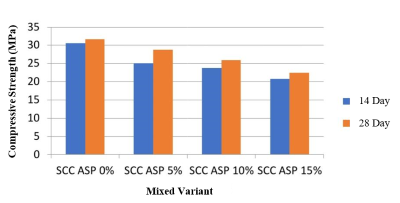The Effect of Rice Husk Ash as Cement Substitution on the Compressive Strength of Self-Compacting Concrete
DOI:
https://doi.org/10.24036/cived.v11i2.493Keywords:
Self Compacting Concrete, Rice Husk Ash, Compressive Strength, Slump FlowAbstract
Self-Compacting Concrete (SCC) is an innovative solution in today's world of concrete technology. Unlike traditional concrete, it does not require a vibrator for compaction, which makes concrete work easier. One of the key features of SCC is its high workability, which is achieved through the use of chemical admixtures and mineral additives. Rice husk ash is one such additive that can be used as a pozzolanic material for concrete mixtures, which is important as rice husk waste can cause environmental problems. The objective of this study was to investigate the effect of rice husk ash on SCC concrete. The study involved using Rice Husk Ash (RHA) as a partial replacement for cement in SCC concrete at varying percentages (0%, 5%, 10%, and 15% of cement weight). The results of the slump flow test showed that the highest value of 775 mm was achieved at 15% RHA, meeting the specifications of SCC concrete. In terms of compressive strength, the results showed that the SCC mixture without rice husk ash (0% RHA) had the highest average compressive strength, which was 30.56 MPa at 14 days and 31.66 MPa at 28 days of concrete. On the other hand, the average compressive strength of SCC concrete with rice husk ash mixture was highest at 5% RHA, with 25.04 MPa at 14 days and 28.81 MPa at 28 days. Overall, the study found that the use of rice husk ash in SCC concrete had a significant effect on its compressive strength, with the highest compressive strength being achieved at 5% RHA.
Downloads
References
Sugiharto, H., &; Kusuma, G.H. (2001). "The Use of Fly Ash and Viscocrete in Self-Compacting Concrete." Civil Engineering Dimensions. 3(2). 30-35.
Ngudiyono, et.al. (2021). "Strong Experimental Study of Self-Customizing Concrete Bone (Self Compaction Concrete)." Proceedings of Saintek. LPPM University of Mataram. Vol. 3. 328-338.
Okamura, H., & Ouchi, M. (2003). “Self-Compacting Concrete.” Journal of Advanced Concrete Technology. 1(1). 5-15.
Sathurshan, M., et al. (2021). “Untreated Rice Husk Ash Incorporated High Strength Self-Compacting Concrete: Properties and Environmental IMPact Assessments.” Environmental Challenges. Vol. 2.
BRS No. 21/03/Yr. XXV. (2022). "Rice Harvest and Production Area in Indonesia 2021 (Fixed Figure)." Central Bureau of Statistics. Jakarta.
Yahya, H. (2017). "Study of Some Benefits of Rice Husk in the Field of Environmental Technology: As an Effort to Utilize Agricultural Waste for the Acehnese People in the Future." Proceedings of the National Seminar on Biotics. UIN Ar-Raniry Banda Aceh. 266-270.
Putro, A.L., &; Prasetyoko, D. (2007). "Rice husk ash as silica on ZSM-5 zeolite synthesis without using organic templates." Akta Kimindo. 3(1). 33-36.
SNI 03-2834-2000. (2000). Procedure for Making Normal Concrete Mix Plan. Indonesian National Standardization Agency.
EFNARC. (2002). Specification and Guidelines for Self-Compacting Concrete. Norfolk UK: European Federation for Specialist Construction Chemical and Concrete Systems.
Nugraha, P., & Antoni. (2007). Concrete technology from the material, and manufacture, to high-performance concrete. Yogyakarta: Andi Publishers.

Downloads
Published
How to Cite
Issue
Section
License
Copyright (c) 2024 Prima Yane Putri, Insannul Kamil, Alfin Rizandi

This work is licensed under a Creative Commons Attribution 4.0 International License.







2.jpg)
